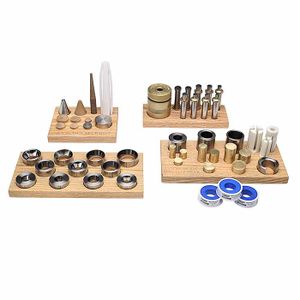Jewelry Station
This Jewelry Station is a set that allows one to turn a coin into a fashionable ring for either yourself or a loved one. Through a process of punching of hole size reductions, forming and polishing, it will bring forth a finished masterpiece in the shape of the ring that you can be forever proud of.
The current Ace of the Jewelry Station is Aiden Teague (ateague23@georgefox.edu).
Documentation
(If you want a PDF manual from Jason's Works, you'll have to pay about $20.00)
Training
There are a wide variety of videos on ring making. The basic process is composed of 3 steps.
1. Punching a hole in your coin. 2. Folding the coin. 3. Sizing the ring.
At various points in the process the metal should be annealed to prevent the metal from becoming too brittle due to cold working. When the coin should be annealed is somewhat subject and no exact rule exists. The hardness of the coin will depend on the type and the year it was minted. For example, silver half dollars minted up to 1964 are made with more silver and less copper than silver half dollars minted afterwards.
Making the ring:
- Punching the hole:
- To begin this process, you want to begin by annealing the selected coin. If you haven't annealed before, it would be best to get a shop supervisor who knows what they're doing to help you out. It might also help to first do this in a darker room to know about how long to heat the coin up for until you see a slight glow. Over heating the coin can cause deformities, and you sure don't want that.
- After annealing the coin, proceed to the coin holder (the giant brass screwy thing) and open it up to find the best fitting spacer to center the coin to the best of your ability. No coin is perfectly circular, so don't waste your time here. Before you actually proceed to punch the hole, make sure to screw the top back into place, and then take the punch (flat side up) and slide it into the hole on top of the coin press.
- In order to get a more secure fit, you can use a paper towel to go around the spacer.
- After everything is in place, using a hammer, slowly hammer the punch through the coin until you feel it give. You don't want to punch it all the way through to the bottom of the press for this might ruin this glorious device.
- You then want to use a rubber or wooden mallet to hammer the punch back out.
- For safety reasons, you will want to de-burr the punched hole to avoid cuts.
- Folding the coin:
- Before you begin to do this, it is highly recommended to anneal the coin to make it more malleable.
- In order to fold the coin, take one of the reduction dyes and find one that fits, but is bigger than the coin. For example, it's recommended to use the 1.3 - 1.4 17 degree dye for a half-dollar, and go down the sizes to eventually fold the ring over.
- It is important to note that you don't want to fold the coin all the way straight just yet, as it will make it more difficult to reduce down the size later!
- Stretching the coin:
- Once you have folded the coin over, it's time to take it to the "stretching tower," again, using a paper towel to protect the details of the coin.
- To begin, you want to measure the coin's current size using the sizing rod, measuring from the smallest side first. Once you have measured the ring's current size, you want to figure out what your target size is and make sure that you stretch the coin one or two sizes bigger (you will be sizing the coin down to the target size).
- As you are working through this, you may want to anneal the coin here and there, making sure that the coin does not become too hard and stiff to work with, causing it to crack like dry skin on a freezing day.
- Sizing the ring:
- From here, take some reduction dyes and size and choose accordingly to reduce the size of the bigger end of the ring, using the press to slowly press the ring into the dye, reducing it. Make sure that you are always reducing form the wider side of the ring!
- As you are making progress here, make sure to check the ring's size using the sizing rod, and anneal as the coin becomes harder to work with, and don't get lazy here. It's better to spend more time annealing and softening the coin rather than having the coin crack and you losing all your hard work!
- Finishing
